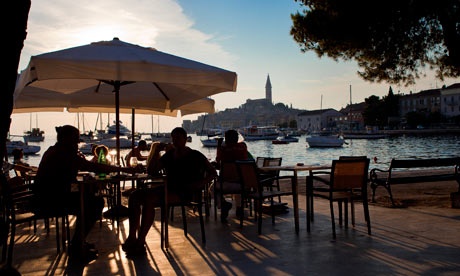
Croatia's pretty north-western peninsula of Istria, on the Italian and Slovenian borders, is a pastoral expanse of ancient forests, traditional villages and gently rolling farmland on the Adriatic.
Famously fertile, over 110 small-scale wineries and 145 olive oil producers have sprung up across the region in the last 20 years, developing its reputation as Croatia's best corner for foodies. There is also a comprehensive network of biking and hiking trails by which to explore them, criss-crossing this 1,400-square-mile peninsula. So I plan a cycling and wine holiday, taking my boyfriend along.
We base ourselves just outside the fishing town of Rovinj, its harbour-side cafes and cobbled piazzas overlooked by streets of handsome baroque and renaissance buildings, built between 1283-1797 when Rovinj was the Venetian empire's prized Blue Pearl.
There, the Hotel Lone, in the Golden Cape national park, offers a stylish introduction to the region's wine and cuisine, and we enjoy a gorgeous first night on the L restaurant terrace, surrounded by ancient oak and pine forest. Wild asparagus, truffled soup and fresh seabass are all locally sourced, accompanied by some fantastic Istrian wines from local wineries including Matosevic, Dobravac and Vivoda. Our cycle route takes shape over dinner.
The next morning we set off to the award-winning Matosevic winery: a moderate 25km ride inland to the tiny village of Kruncici, high on the banks of the picturesque Lim fjord. It isn't necessary to hire a guide, but it turns out to be an excellent decision. Within minutes of setting off, Boban Memedovic (local teacher-cum-formidable cyclist) leads us onto quiet country lanes and unsealed trails.
Soon we're pedalling past ancient churches and abandoned train tracks; colours are primary: bright blue sky, vivid green trees, field upon field of iron-red soil. Rows of olive trees and grapevines stand sentry over smallholdings of tomato, courgette and feathery sweetcorn. As the road dips down, the fields rise up: there are fields of orb-shaped onion flowers on thick stems that resemble disco balls. Drinking water in dappled forest shade, Boban points to wild asparagus growing by the roadside. Come autumn, there will be prized truffles and mushrooms too.
The air is steeped in rosemary and birdsong; butterflies flit by as we crunch over rock-packed paths. It's hot, over 43C by the time we start the steep 3km climb up the Lim Valley. We arrive at Matosevic winery and collapse in the shade of a cherry tree.
Istria has a long tradition of wine-making, but with the emphasis on quantity rather than quality (particularly when the region was part of communist Yugoslavia). But in the late 90s, a wave of young Croatian wine-makers started working with malvasia, a neglected Istrian white grape, unfashionable because of its perceived poor quality, and also teran, a better-regarded dark varietal. Applying the latest in wine technology and stringent quality control, Istria's wine producers started winning awards, from a 2012 Decanter to near-perfect scores from leading US wine critic Robert Parker.
Typical of Istria's garage wineries, Matosevic is small, – really just a farmhouse – but from crushing to aging and bottling, everything is done here. And the wine is very good. We sip our way through the Matosevic family tree: 10 lines, from the light, fruity alba white, to the dark, chocolate-spice grimalda red.
Boban further brightens our mood when he mentions that instead of cycling the 20km back to Rovinj, we can sling our bikes on the Lim fjord ferry just down the road. Soon we're sailing the Lim's turquoise waters, past oyster and fish farms, ancient caves and deep forests. This sense of land and tradition sparking a new wave of creativity – a kind of social terroir – is something we come across repeatedly over the next few days.
Back in Rovinj's pretty harbourside and twisty cobbled streets we find the usual pizza joints, but mixed in with some seriously good restaurants and bars. Kantinon features traditional seafood dishes, presided over by Emil Perdec, Croatia's foremost sommelier; Grota is Igor Zuzic's basic marketside bar, serving his hugely popular wine, cheese and cured meat. Next to Hotel Lone, upscale Hotel Monte Mulini offers daily tastings of 600 wines: the hotel's sommelier describes the character and provenance of each wine (and 15 olive oils) with the passion and affection most men reserve for football. Their Wine Vault restaurant serves imaginative Istrian dishes by revered chef (and Croatian MasterChef judge) Tom Gretic.
Finally, we visit the multi-award winning Dobravac winery and olive oil farm, where Natalie Dobravac gleefully describes the satisfaction of farming "a small piece of land that produces everything''.
So perhaps delicious Istria has been hiding in plain sight. As Emil Perdec observes: "My family has lived in Istria for 120 years, every generation under a different country's government. Governments change, but this is always Istria."
• The trip was provided by Hotel Lone (+385 52 800 250, lonehotel.com); doubles from £102 a night, including breakfast, free bikes and spa access. Guided bike ride to Matosevic (arranged through hotel) costs £64. Boat ticket per adult along Lim fjord to Rovinj costs £13 one-way. Wine tasting is free for individuals, £8pp for groups of five or more. Tastings are by appointment only: Matosevic (no phone, matosevic.com/en); Dobravac (+385 52 813 006, no website). Thomson, Ryanair and Jet2.com fly to Pula from various UK airports

